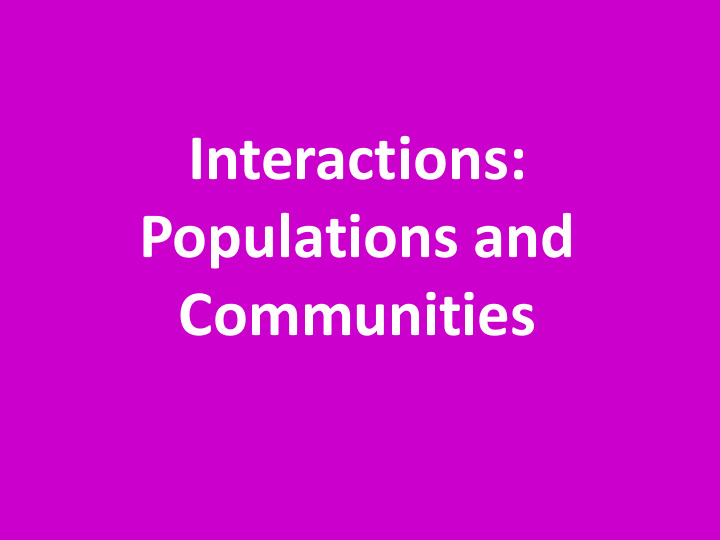



Interactions: Populations and Communities
Population Interactions • A population of organisms has properties that are different from those individuals that make up the population • Cooperation and competition between individuals contribute to these properties
Population Interactions • Relationships among interacting populations can be characterized by positive and negative effects , and can be modeled mathematically
Community Interactions • Classified by whether they help, harm or have no effect on the species involved • Species interactions strongly influence the structure of communities • Community : A group of populations of different species in an area
Examples of Community Interactions • Interspecific competition (-/-) • Predation (+/-) • Herbivory (+/-) • Symbiosis - Parasitism (+/-) - Mutualism (+/+) - Commensalism (+/0)
Interspecific Competition (-/-) • Individuals of different species compete for a resource that limits their growth and survival
Predation (+/-) • An interaction in which one organism captures and feeds on another organism • Predator and prey • What are some advantages of predation? (Think!)
Canadian Lynx and the Hare
Herbivory (+/-) • Interaction in which an organism eats parts of a plant or alga
Plant Defenses Against Herbivory • Chemical defenses – produce chemicals that are toxic or taste bad • Mechanical defenses – prickles, thorns, spines or trichomes • Thigmonasty – responses to touch, leaves curl up or close • Leaf shedding or warning coloration
Symbiosis – Parasitism (+/-) • A symbiotic relationship in which one organism benefits at the expense of the other organism
Symbiosis – Commensalism (+/0) • A symbiotic relationship in which one organism benefits and the other organism is neither helped nor harmed
Symbiosis – Mutualism (+/+) • A symbiotic relationship in which both organisms benefit
Community Interactions • Structure of a community is measured and described in terms of its biodiversity , which is measured in species richness (total number of different species in a community), and the relative abundance of each species present
Community Interactions
Ecosystem Stability
Abiotic and Biotic Factors Affect Stability • The stability of populations, communities and ecosystems is affected by interactions with abiotic and biotic factors • Examples: food chains and food webs, algal blooms, species diversity, population density
Food Chain Stability
Food Web Stability
Algal Bloom • Rapid increase in the population of algae in an aquatic ecosystem • Usually caused by an excess of nutrients, such as phosphorus (abiotic factors) • Why are algal blooms harmful?
Species Diversity Within Ecosystems • Diversity of species within an ecosystem may influence the stability of the ecosystem – Keystone species – Producers – Essential abiotic and biotic factors
Keystone Species • A species that is not necessarily abundant in a community yet exerts strong control on community structure by the nature of its ecological role or niche • Removal of a keystone species often results in the collapse of the ecosystem Examples: Sea otters, sea star, tiger sharks
Pisaster ochraceus
Cooperative Interactions
Competition and Cooperation • Competition and cooperation are important aspects of biological systems • Cooperative interactions within organisms promote efficiency in the use of energy and matter – Cellular level – Multicellular organisms – Populations of unicellular organisms
Cooperative Interactions • Cellular level: Plasma membrane, cytoplasm and, for eukaryotes, the organelles contribute to the overall specialization and functioning of the cell
Cooperative Interactions • Multicellular organisms: specialization of organs contributes to the overall functioning of the organism – Exchange of gases – Circulation of fluids – Digestion of food – Excretion of wastes
Cooperative Interactions
Cooperative Interactions • Interactions among cells of a population of unicellular organisms can be similar to those of multicellular organisms • Interactions increase efficiency and utilization of energy and matter Example: Deep sea vent community
Deep Sea Vent Community • Bacterial community in and around deep sea vents • Chemosynthetic bacteria are the primary producers of the food chains of hydrothermal vents • Symbiosis: chemosynthesizers and respiring heterotrophs
Quorum Sensing • Another example of cooperative interactions between bacteria of the same species and different species • Used to coordinate certain behaviors such as biofilm formation and virulence, based on the local density of the bacterial population
Ecological Succession • Succession : the process of change in the species structure of an ecological community over time – Primary succession – bare rock or sand, no soil present – Secondary succession – soil is established – Pioneer species – the first species to arrive, differ between primary and secondary succession
Primary Succession
Secondary Succession
Recommend
More recommend